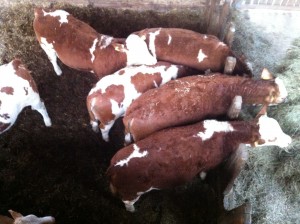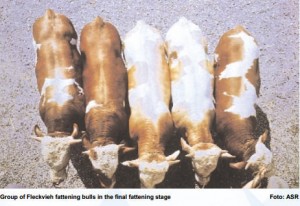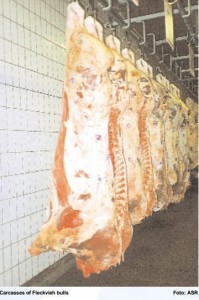Why Fleckvieh bull calves can become more than a by-product
Excerpt of Fleckvieh world – www.bayerngenetik.de and www.betterdairycow.com experiences:
For Fleckvieh farmers in Bavaria it is the most normal thing on earth to produce quality beef via slaughter cull cows or bull calves out of dairy farms. Holstein farmers who focus on milk production only and who regard bull calves as an unwelcome by-product have to rethink their economic strategies when they start to work with Fleckvieh. This process is rewarded very soon through the fact that a higher income can be realized through the selling of bull calves for feedlot use.
The strict separation between milk- and beef production – as it is common in many countries – is unusual for Fleckvieh dairy farms. In the future – with increasing human population growth, a quality product bull calf will be derived from many dairy farms across the world. The Fleckvieh-cow or the Fleckvieh x Holstein crossing cow with its outstanding carcass qualities offers a new source of income since well grading carcasses result from slaughter animals. With the following example of a Fleckvieh bull calf rearing process, you can see first hand in this description what a Bavarian Fleckvieh calf can do for the farmer.
1st phase of a bulls life:
Birth of the calf : After it was fed colostrum within 2 hours after calving the newborn calf is put into a box on a straw bedding and marked with two ear tags. It remains for about 14 days in that box. 85 kg. When they reach this weight about 50% of the bull calves are sold at the auction places owned by the breeding associations. These quality calves are bought either by farmers who are specialized on the production of weaners out of dairy farms or by feedlot operators/finishers. The Fleckvieh breeding associations sell about 1.000 bull calves a week to everywhere in Germany and the adjacent countries. Based on pricing, weaner calves form dairy farms are highly regarded by feedlot operators/finishers.
2nd phase of a bulls life:
Production of a weaned bull calf: The weaning of the bull calves from milk or milk substitute is done in farms that are specialized on weaning or directly on the fattening farms. To adapt the calves to ruminant appropriate feed and with this to an intensive further fattening, demands a lot of expertise, one reason more to hire specialized farms for this.

3rd phase of a bulls life:
Bull fattening has a long tradition in Bavaria and is the main way of producing beef in Bavaria. Fattening steers is not very common, since the use of hormones to improve the fattening process is not allowed in Germany and thus there is no use in castrating bull calves. From 11 to 13 months the fattening bulls are fed a high energy ration (corn silage) till they have a lifeweight of 700 – 750 kg. The carcass should have a weight of 380 – 400 kg. The classification of the carcasses is done by independent experts after the EU carcass grade system (EUROP). Two thirds of the Fleckvieh-carcasses reach the desired E and U carcass grades, which guarantee a better payment. 89% of all bulls slaughtered in Germany are fullblood Fleckvieh bulls. All slaughter dates are noted down in the slaughter house and later used for the estimation of the breeding values. There is no other breed worldwide that has so many data from beef production as Bavarian Fleckvieh.

The Bavarian system to produce beef from Fleckvieh bull calves out of dairy production guarantees highest beef qualities. This helps to improve the economical effectiveness of dairy farms which means a higher income for them. Even for F1-crossing calves Fleckvieh x Holstein good prices are paid and give a first feeling of success to the farmers that switch from Holstein to Fleckvieh. Calves sired by Fleckvieh bulls are quality products in demand and not a low regarded waste product of dairy farms. Fleckvieh – born to be economic and to gain the confidence of the consumer.
Many farms in North America have seen the same benefits. A large lot of Fleckvieh cross calves were fed to a finish weight between 1800 to 2200 lbs on one farm in Southern Manitoba. The animals were sent to slaughter and carcass yields of 55% to 58 %. This made the enterprise of feeding a worthwhile one for this dairy farm. The author has seen many cull slaughter Fleckvieh cross cows that were sent to the packing house in the United Sates straight South of their Manitoba farms of origin. Again their slaughter yields are a phenomenal 55% to as high as 63%. Compared to the average cull Holstein cow at 37% one can immediately see the difference.